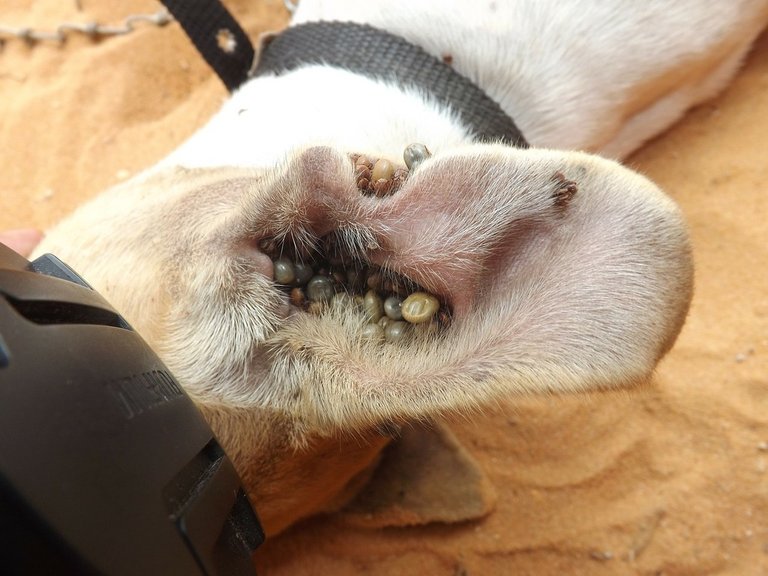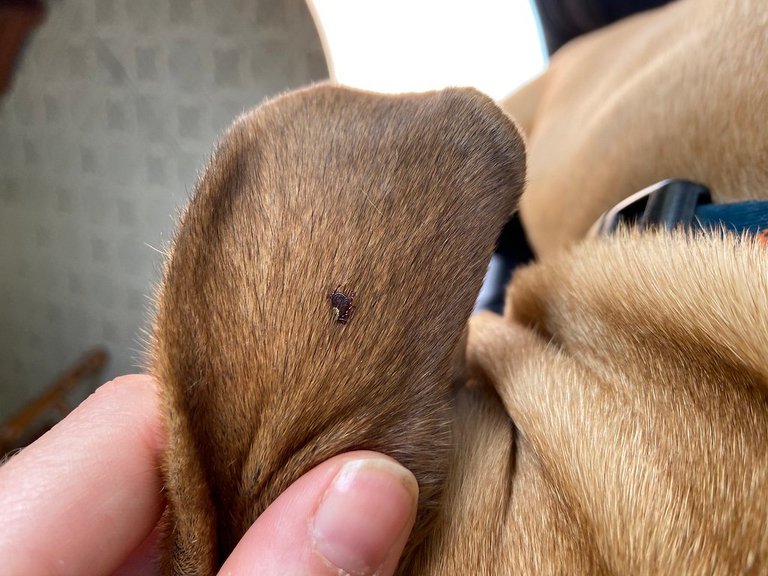I saw a dog today and I felt so sad for the dog, the number of ticks on the body of the dog was very alarming. I could not stop asking myself if the dog owner knows the effect of having your pet infested with ticks. So, let's talk about tick-borne diseases today.

Image credit
Ticks are intracellular parasites that can suck blood from their hosts, and then transmit dangerous bacteria to the body of the affected pet. Upon transmission of the bacteria, they live inside the cells and have the potential to cause several illnesses that would cause infection in dogs every year.
Conditions that occur due to tick bites can also cause long-lasting damage, this is the reason why experts always advise that it is best to prevent tick-borne diseases from happening in the first place, and this is only possible by protecting your pet from tick bites.
Many of the pathogens that cause tick-borne diseases are zoonotic meaning they can spread from animals to humans, but this disease cannot directly spread between dogs and humans.
Pathogens are required by these ticks to complete their life cycle and become infectious. This means a direct tick bite is needed for the transmission of disease, the tick needs to be fed within 24-48 hours before it infect a host.

Image credit
Ticks can transmit a single type of organism or multiple types through a single bit, this single bite would allow different organisms to work together to release toxins and release the immune system of your dog.
Once these organisms can find their way to your pet, they will invade the dog's cells and hijack the immune system. Some of the organisms that tick spread are very capable of helping each other survive well in the body of your pet, leading to a case of chronic or recurring infections.
Here are common tick-borne diseases that may have a strong effect on your dear pet;
Canine Bartonellosis: This is one of the less common blood-borne diseases in dogs, and it is transmitted by a brown dog tick. This condition could create very disturbing symptoms like fever, seizures, irregular heartbeat, loss of appetite, and lameness to altered brain function.
Lyme Disease: This is caused by the bacteria, Borrelia burgdorferi which is transmitted by an infected black-legged tick or deer tick. Lyme disease can affect dogs and humans across North America. Lyme disease has symptoms that include; fever, joint pain, lameness, lethargy, swelling, and enlargement of lymph nodes.
Rickettsial Diseases: Rickettsia is a bacteria that causes a widespread tick disease, this organism comprises a small, intracellular bacteria. Rickettsial bacteria can cause illnesses like; Rocky Mountain Spotted Fever, Canine Anaplasmosis, and Ehrlichiosis.
Canine Anaplasmosis: Also called dog fever or dog tick, the tick carries the disease. An infected host could experience symptoms that are similar to some other tick-borne diseases. Symptoms like; fever, stiff joints, lethargy, vomiting, appetite loss, diarrhea, and seizure in extreme cases.
Canine Ehrlichiosis: Different types of ticks are responsible for the transmission of Canine Ehrlichiosis. The symptoms of this condition usually begin around 1-3 weeks after your dog has been infected. It has symptoms like; loss of appetite, fever, bruising, and nose bleeding.
Protozoal Disease is an intracellular parasite that lives in the red blood cell of your dog and can cause; canine Babesiosis, and canine hepatozoonosis.
Each type of tick has its symptoms, but the general symptoms you may want to pay attention to include; skin lesions, depression, fatigue, seizures, swelling in the limbs, muscle pain, weight loss, and nose or eye discharge.
In the process of trying to remove a tick from your pet yourself, you may end up hurting your pet, and that is why it is important to get the help of a professional.
I mentioned previously that it is better to look for ways to prevent the occurrence of tick-borne diseases, but there is no perfect tick control system, so it is advisable that upon visiting a pet-infested environment, you properly inspect yourself and your pet for any presence of tick.
Also, check your pet from time to time for the presence of any form of tick, as some of them are periodic, and when you find one, get it removed instantly (preferably by a professional) to prevent the transmission of an infection.
If you are removing the tick from your pet by yourself, use tweezers to gently grasp the tick close to the tick and pull it out gently. Do not remove a tick with your bare hands because some tick-borne diseases can be transmitted instantly through a break in skin or contact with mucous membranes.
Conclusion.
Ticks are of different types and so are their symptoms, protecting your pet from tick infection is the best way to go, and the moment you notice any tick at all on the body of your pet, consult a professional help to get rid of it, to prevent the risk of infection or damage.
References.
vcahospitals.com/know-your-pet
petmd.com/dog/conditions/infectious-
akcchf.org/canine-health/sporting
lakecross.com/site/blog-huntersville
Congratulations @futurekr! You have completed the following achievement on the Hive blockchain And have been rewarded with New badge(s)
Your next target is to reach 450 posts.
You can view your badges on your board and compare yourself to others in the Ranking
If you no longer want to receive notifications, reply to this comment with the word
STOPCheck out our last posts:
Thanks for your contribution to the STEMsocial community. Feel free to join us on discord to get to know the rest of us!
Please consider delegating to the @stemsocial account (85% of the curation rewards are returned).
Thanks for including @stemsocial as a beneficiary, which gives you stronger support.